Prospecting & Detecting
Free / Prospecting & Detecting
Prospecting Australia—Part II: There and Back Again
November 2011 by Chris
Last month I wrote about my pending month-long trip to Western Australia and the geology of the area. In late August, I boarded a plane and began my trip in earnest. I met up with my friend Steve Herschbach of Anchorage at the Los Angeles airport for the long flight across the pond to Australia. The flight over the Pacific was fine, just very, very long. It was a red-eye flight, and I probably slept 7 hours of the 15 hour trip. To reach our destination we spent a total of around 21 hours in the air and a lot more waiting around in airports. Though a little tired, we arrived none the worse for wear and adjusted to the new time fairly easily. Luckily, all of my luggage got through just fine with none lost.
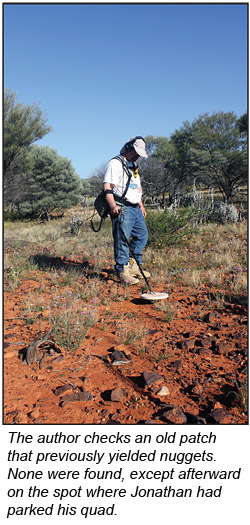
The end of our flights and start of the next part of our journey to the outback was Perth. Perth is a pretty town of 1.5 million people on the Western Australian coast, facing the Indian Ocean half a globe away from my home, but the weather and all the eucalyptus trees reminded me of Los Angeles—some homes even had a few cactus imported from the US. It’s actually not a coincidence because Perth is on the ocean at exactly the same latitude as LA, but in the southern Hemisphere. We met up with Jonathan Porter, ICMJ writer and well-known Australian professional prospector, at the airport. On our first full day in Australia we went to Reed’s, the local prospecting shop. They hosted a send-off barbecue for us, and about 100 folks came by to wish us luck. It was great to talk “shop” with a number of Aussie prospectors.
After buying our food and various camping supplies we didn’t bring with us, we headed out to the deserts of the outback. Jonathan and his friends had been finding some nice gold, and we went to an area Jonathan suggested where he had been successful in the past. We arrived at our destination early in the evening and began pitching camp in the last light of dusk. The next morning, which was our first day in the field, Steve got his first nugget within minutes of turning on his metal detector. It only took me about an hour to find my first piece. I think I got 5 nuggets that day for a total of 1/10th of an ounce. Each day we would gear up between 7:30 and 8:00am, work until noon, take an hour break for lunch and then detect for gold again until about 5pm. Although you move slowly, listening for the sound of a target, we walked many miles each day.
During the month, we traveled around and camped in 4 different areas, heading out each day to explore and work patches in various areas within a reasonable driving distance from where we were camped. Visiting all these different places we saw a lot of country, each location with its own unique features, and we got at least some gold nearly every day. Often we camped right on or very near gold-bearing patches of ground.
We had a fine time with Jonathan, and the other people we spent time with were great as well. JP was an amazing host and entertainer—it was always fun spending time with him. In fact, one of the best things about the whole trip was getting to know JP better. He was very helpful with advice, observations and other input. When the evening conversations would slow, he always had a few jokes to liven things up. Of course he was also very knowledgeable about the areas we were visiting, and the gold-bearing spots that had been productive. He proved himself to be a fine camp cook. Even though we volunteered to cook, I think he felt safer doing it himself!
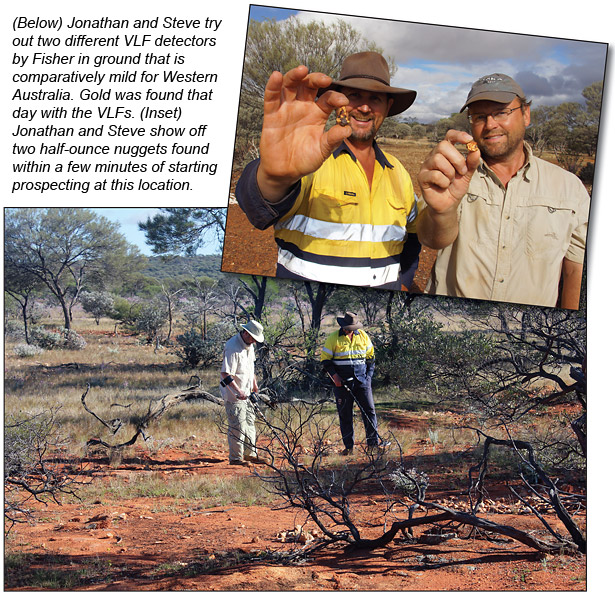
He did a great job of getting us out to different patches and gold-bearing areas. One of the most amazing things about JP is his boundless passion for finding gold. For a guy who has found thousands of ounces of gold and many, many good-sized nuggets, you’d expect that anything less than several ounces in size would be a pretty ho-hum occurrence. Yet as I watched him dig a half-ounce nugget he was so excited digging that his hands were visibly shaking! He just really enjoys finding nice nuggets.
During the evenings, the three of us had many interesting campfire discussions about gold, Australia, the US, politics and many other topics. Jonathan is as knowledgeable as anyone on the planet concerning the operations of Minelab detectors, and it was interesting to talk with him about their operation and prospecting with metal detectors in general. For our contribution to the campfire discussions we tossed in a bunch of bear stories as Australian prospectors seem to have an unusual interest in bears.
JP also did a great job of showing off the best of Australian wildlife to us, no matter what it took to do so. One day, when he was out on his quad, he saw an echidna—an anteater with the spines of a porcupine—and brought it over to our location. The echidna was an amazing thing to see. It was carefully returned to the wild unharmed. Another time we were standing on the edge of a small open-pit gold mine looking at a small flock of wild goats about 100 yards away that had wandered down into the pit to partake of the standing water at the bottom. (There is very little surface water in that part of Australia.) JP threw a small rock at the herd to get them to move and hit one right on the head! Since these goats challenge each other in head butting contests, they have very thick skulls. It shook off the blow in only a couple of seconds and ran off to join the herd.
The weather was beautiful and the geology different and fascinating. Steve and I were both struck by how many gold areas were covered with chunks of magnetite iron ore. The Meekatharra, Cue and Wiluna region of Western Australia where we camped was just beautiful in September this year. Because of rains earlier in the year, there were fields of wildflowers and short grasses growing everywhere. The terrain was flat with low, rolling hills, and with all the flowers, many of the gold-bearing places looked like some kind of park. However, also because of the rains, the flies were really bad—locals told us they were the worst in a decade. At times I had as many as 300 flies buzzing around me. They did not bite, but were very, very aggressive. They would fly up your nose, into your ears, your mouth and eyes. Even if you waved them off, they would fly away about a foot, then turn around and land right back where they started. I wore a head net to keep them out of my face, eyes, nose, mouth, etc. I found I just could not concentrate on the sounds of my metal detector while they were flying up my nose. With the netting, they landed on my arms, legs and chest instead. They were like nothing I’d ever seen and were active from about 9:00am to sunset. Mosquitoes came out near sunset, and they did bite.
I’d camped out for more than a week before, but never even as much as two weeks—this time I was out for a whole month. I quickly found that the thin foam mattress I’d purchased at a camping supply store in Perth was not enough to soften the hardness of the ground. Because of that, I spent a month looking forward to sleeping in a real bed. However, sleeping on the ground, I got a feel for what the early day pioneers and miners must have gone through. Some nights we had campfires and cooked over the coals, other nights we just used some electric lights to sit and visit. One of the things I hoped for was that we’d see new and different things, and we definitely got to do plenty of that. Just about every day we saw something new or unexpected—animal life, geology, etc. I saw the Magellanic clouds in the sky each night—and all the stars in the Milky Way were spectacular. I saw lots of wildlife including kangaroos, an echidna, emu, wild parrots, giant lizards and eagles. We saw a whole flock of wild emu, which are similar to ostriches, as they ran across the road in front of our car. I also lost about 14 pounds by walking 7 or 8 hours a day and camping where I could not buy any snacks or other goodies.
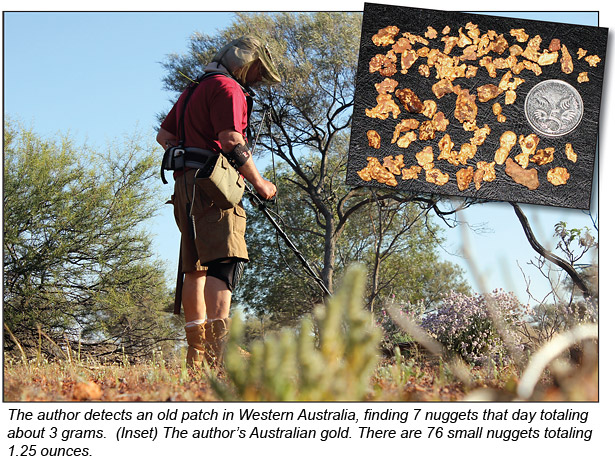
On the cost of things, I really had my eyes opened. Since our two country’s dollars are more or less near parity in international exchange, I expected that costs of various goods would be more or less the same; they are not. On our initial trip out of town into the outback, we stopped at a gas station and bought a few snacks. They would have cost about $5 or $6 in the US, but were over $10 in Australia. A candy bar I can buy here for $1 is $3.50 over there; the camping mattress I can bu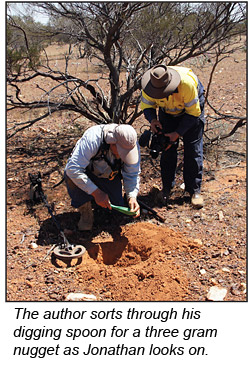 y here for $30 is $60; and the pound of hamburger I can buy here for $3.50 is $7.50. Part of the reason is that taxes on wages and businesses are much higher and those costs all get passed along. Another reason is that the Aussie minimum wage is much, much higher than that of the US. However, if you make 50% more than an equivalent person in the United States, but all the basics you need for life—like food, gasoline, clothes, rent, etc.—cost 50% to 100% more than in the US, what advantage is your higher wages? There really is none.
y here for $30 is $60; and the pound of hamburger I can buy here for $3.50 is $7.50. Part of the reason is that taxes on wages and businesses are much higher and those costs all get passed along. Another reason is that the Aussie minimum wage is much, much higher than that of the US. However, if you make 50% more than an equivalent person in the United States, but all the basics you need for life—like food, gasoline, clothes, rent, etc.—cost 50% to 100% more than in the US, what advantage is your higher wages? There really is none.
I did OK finding gold, but I wouldn’t call it “exceptional.” I got some nice gold—about 1.25 ounces. It was not enough to pay for the whole trip, but it paid for most of it. Steve did better and got almost 2.5 ounces while JP recovered around 4 ounces during our time there. Part of the reason for my smaller total was just, for whatever reason, I simply could not get my detector over anything of any size. A nugget of about 3+ grams (1/10th ounce) was my largest on this trip. There were a number of other reasons: We spent about 5 days prospecting new areas and found nothing there, but it’s hard to find new patches if you just look in the same old places. Another reason is that we also found that there are many, many folks from all over the country out there pounding the old patches because of high gold prices. We visited a number of Jonathan’s “secret” patches and found others camping on them or new roads accessing them and obvious signs of new work. People were even following our tracks just to see where we were going.
Although the gold-bearing areas extend over many hundreds of miles, every new patch that is found is one fewer that’s out there to be discovered, every nugget recovered in an old patch is one fewer to be taken. There are still new patches being found, but there are fewer new patches found each year,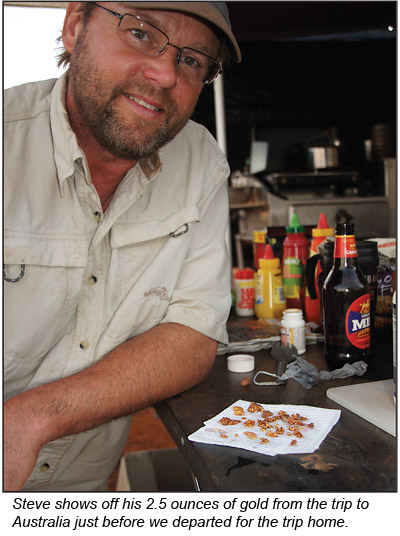 and the old places are just getting beaten to death. Situations where prospectors are getting an ounce or two per day are getting rarer and rarer. There is still plenty of good gold to be found—don’t get me wrong, people are still making good finds—it’s just not as easy as it was 10 or 15 years ago. In fact, at one point JP asked us if there was anything we would do different about our trip, and Steve and I both agreed—we would have come 10 years ago. The other thing I’d have done differently is buy a thicker foam mattress to sleep on that hard ground for a month!
and the old places are just getting beaten to death. Situations where prospectors are getting an ounce or two per day are getting rarer and rarer. There is still plenty of good gold to be found—don’t get me wrong, people are still making good finds—it’s just not as easy as it was 10 or 15 years ago. In fact, at one point JP asked us if there was anything we would do different about our trip, and Steve and I both agreed—we would have come 10 years ago. The other thing I’d have done differently is buy a thicker foam mattress to sleep on that hard ground for a month!
All considered, my trip to Australia was great, and everything went very well—no injuries, no problems, no worries. I had a grand time, and really want to thank Jonathan for his invitation, as well as all his help and assistance. I learned a lot, and had an opportunity to experience that part of Australia up close. Australia is a great country, and I truly enjoyed my visit—it was everything I’d hoped for. I met a lot of great Aussie prospectors and really enjoyed my month stay in that country. Australia has many, many good things going for it, and the state of Western Australia is a simply wonderful and amazing place. I hope to be back for another visit in a few years.
For those interested in their own adventures prospecting through Australia, there are a number of outfits that offer nugget hunting tours—we went with JP by private invitation but he does not offer tours. I have talked with a number of friends who have gone on these tours and almost universally they found them very enjoyable and interesting. A quick search through the Internet will reveal a number of them.
Next month we will finish up by taking a look at typical nugget patches in Western Australia. Most of the nugget gold there occurs in discrete, specific areas, and it’s something that I think will have applications to prospecting here in the US as well. We will look at their geology and what its like to detect them.
© ICMJ's Prospecting and Mining Journal, CMJ Inc.